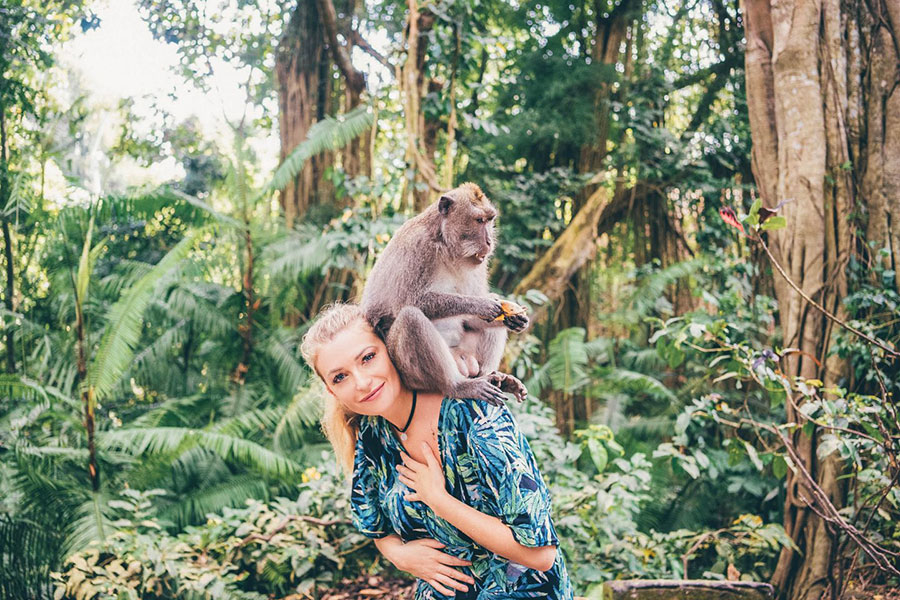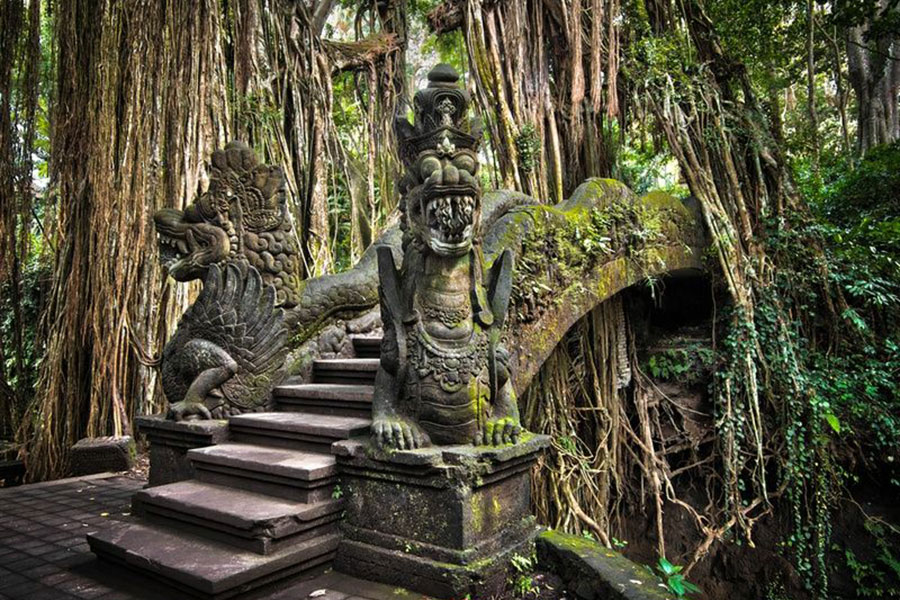BALI UBUD MONKEY FOREST
BALI UBUD MONKEY FOREST IS A NATURE RESERVE AND TEMPLE COMPLEX IN UBUD VILLAGE ALSO AS A PLACE OF SACRED MONKEY FOREST SANCTUARY

Bali Ubud Monkey Forest, or officially called Padangtegal Mandala Wisata, is a nature reserve temple complex located in Ubud, Bali. It is a small rainforest inhabited by a group of monkeys and various other tropical animals. It is strategically located in the center of Ubud Village. In Balinese, the monkey forest is called Wanara Wana, which is spread all over Bali Island. The Ubud Monkey Forest plays an important role in maintaining the monkey habitat in Bali. The local community also plays an important role in maintaining the natural preservation of this forest, ensuring that all wild animals can live well. Despite being in the center of Ubud town, this small tropical forest offers a very beautiful natural landscape. Aside from seeing the monkeys that live here, visitors can also visit the temples within. The beautiful greenery that surrounds the place also adds to its appeal, making it an ideal playground for the monkeys that live there. Bali Ubud Monkey Forest is also one of Gianyar places of interest, adding to the list of must-visit destinations in the area.
If you visit Ubud Monkey Forest, here’s what you need to know:
- Location Ubud Monkey Forest
- Ubud Monkey Forest History
- The Wanara Wana Ubud
- Long Tail Macaques at Ubud Monkey Forest
- Conservation at Ubud Monkey Forest
- Tri Hita Karana Concept at Ubud Monkey Forest
- Temple at Ubud Monkey Forest
- Facilities at Ubud Monkey Forest
- Need to Know about Ubud Monkey Forest
Location Ubud Monkey Forest
Ubud Monkey Forest is a sacred place located on the southern border of Ubud town, about 3 kilometers from the town center, with the main road also named Monkey Forest. The location can be reached from various directions, both from Ubud town center, the eastern corner, and the southern area. It is about 55 kilometers from Kuta, 40 kilometers from Sanur, and 65 kilometers from Nusa Dua. Since it is located in the center of Ubud, finding Ubud Monkey Forest is very easy with the help of Google Maps and directions at every intersection. If you want to visit Ubud Monkey Forest along with other tourist destinations in Ubud, a Full Day Ubud Tour package is available. Meanwhile, if you only want to spend half a day there, there is a Half Day Ubud Tour package at an affordable price. We from Bali Driver Hire also provide transport services at low prices to Ubud Monkey Forest and other destinations in the vicinity.
Ubud Monkey Forest History
The establishment of Ubud Monkey Forest has no definitive record of the exact time, but based on the Pura Purana lontar, the temples in Ubud Monkey Forest are thought to have been built around the 14th century, when the Pejeng Dynasty ruled, or the early Gelgel Dynasty. If this estimate is correct, the temple existed before 1343 AD, not when Puri Gelgel was founded in the 17th century. The main purpose of establishing Ubud Monkey Forest is based on the concept of Tri Hita Karana, which emphasizes the importance of harmonious relationships between humans and the environment. It encompasses a 12.5-hectare sacred area containing three holy temples, namely Dalem Agung Temple, Beji Temple, and Prajapati Temple, which are considered sacred by the local community. The Udayana University study also noted the presence of 115 tree species in Ubud Monkey Forest, some of which are considered sacred and important in Balinese Hindu religious rituals. For example, the trunks of Majegan trees are used to build temples; Banyan trees are used for cremation ceremonies, and Pule Bandak trees symbolize forest spirits and are used in making sacred masks. In addition, Ubud Monkey Forest is also a habitat for long-tailed monkeys, with a total of 800 monkeys inhabiting the area.

The Wanara Wana Ubud
Wanara Wana is a Balinese term consisting of the words “Wanara” meaning “Monkey” and the word “Wana” meaning “Forest“, so when translated into Indonesian, it means “Monkey Forest”. The term is derived from Sanskrit, which once influenced the religious life and mastery in the archipelago before the Islamic period, and this tradition is only maintained in Bali today. It is important to respect the monkeys, as the forest is their home and visitors are guests in their environment. Always stay on designated, paved trails. The monkeys may exhibit aggressive behavior if they feel their personal area is being disturbed. Staff and researchers at Ubud Monkey Forest may be seen around, but it is important not to follow them as they are responsible for keeping the forest safe and comfortable for the apes and visitors. Always be vigilant and respect the rules to avoid unwanted situations.
Long Tail Macaques at Ubud Monkey Forest
In the world, there are about 200 species of primates, including apes and monkeys, and about 40 species, or nearly 25 percent of the total, can be found in Indonesia. One of these is the long-tailed macaque (Macaca fascicularis), which is native to Southeast Asia but is now widely distributed across Asia. Macaca fascicularis, or long-tailed macaque, is the most common monkey species found in Southeast Asia, including Brunei Darussalam, Cambodia, Indonesia, Laos, Malaysia, Myanmar, the Philippines, Singapore, Thailand, Timor Leste, and Vietnam. They can also be found in Bangladesh and India. Typically, long-tailed macaques form groups of up to 20-30 individuals, with 2-4 adult males and the rest females and young. Their diet includes a variety of fruits as well as hunting small animals such as crabs, insects, eggs, and more.
The monkeys living at the sanctuary are long-tailed macaques, scientifically called Macaca fascicularis. Apart from humans, macaques are the most successful and widespread of all primates. They typically live in groups of three, consisting of females and males, with each group tending to use a different area of forest at any given time. However, all apes use the entire forest area, and conflicts can occur when two groups share the same area. Adult male apes weigh around 8 to 10 kg and are equipped with large canines, broad shoulders, and whisker-like hair. Adult females, meanwhile, are smaller and weigh between 4 to 8 kg, with long facial hair that resembles beads. These ape groups typically gather around groups of females called “matrilines”, with males often migrating from other areas to join matriline females. Within ape groups, there is a dominance hierarchy between males and females, although this relationship is not always clear or consistent. Mating can occur throughout the year, but the majority of infants are born between May and August. Mother apes have a variety of attitudes toward their babies, ranging from highly protective to very permissive. Many females who are not mothers are also involved in caring for and carrying the babies. Sometimes, you will even see adult males taking care of baby macaques.
Conservation at Ubud Monkey Forest
Ubud Monkey Forest Sanctuary is a complex home to around 340 monkeys (Macaca fascicularis), consisting of 32 adult males, 19 sub-adult males, 77 adult females, 122 juveniles, and 54 infants. These monkeys are crab eaters and are often seen eating coconuts. In addition, they also enjoy foods such as bananas and papaya. If you feed the apes, do so carefully, and if they take food from you, do not try to take it back. It is very important to treat the trees, plants, animals, and buildings in this sacred monkey forest with the utmost respect. The Ubud Monkey Forest Wildlife Sanctuary is not only a spiritual and everyday place for the villagers, but it also hosts research and conservation programs. The management and maintenance of this place attract the attention of researchers from all over the world, especially in the interaction of humans with the monkeys in this sacred area, which is the focus of surveys and research. This area is crucial for ecological conservation and is a sacred place that needs to be respected. Enjoy the beauty and magic of Ubud Monkey Forest Sanctuary while respecting the life within. If you have any questions or need help, don’t hesitate to ask the Wenara Wana officers, who usually wear green uniforms, or members of the research project.
Tri Hita Karana Concept at Ubud Monkey Forest
Tri Hita Karana is a philosophical concept that combines the words “Tri” meaning three, “Hita” meaning happiness, and “Karana” meaning cause. Thus, Tri Hita Karana implies the three causes of happiness. This philosophy is a responsible way of life that aims to maintain cultural and environmental diversity in the midst of globalization and homogenization. At the core of the Tri Hita Karana teachings are three important relationships in human life in this world. The three relationships include:
- Humans with God: Humans are creations of God, and the existence of Atman within them is part of the greatness of God that gives life to humans. From this perspective, man actually has a moral obligation (owes his or her life) to God. Therefore, every human being is expected to be grateful, devoted, and always prostrate to God. This expression of gratitude and devotion can be done through worship, adoration of God’s greatness, such as carrying out His commands, traveling to holy places (tirtha yatra or dharma yatra), practicing yoga and meditation, and practicing religious teachings with full earnestness.
- Humans with the Natural Environment: Humans live in an environment that provides for their various needs. Therefore, humans are very dependent on their environment and must protect and take good care of it without destroying it. This includes protecting the environment from being polluted or damaged in a way that can disrupt the balance of nature, such as protecting forests from overlogging and protecting animals from uncontrolled hunting. On the contrary, the environment must be kept clean and preserved in order to create beauty that provides a sense of calm and peace for humans.
- Humans with Other Humans: As social beings, humans require interaction and cooperation with others. Therefore, human relationships should be based on mutual respect, love, and guidance, known as the principles of mutual hone, mutual compassion, and mutual care. This means maintaining harmony and order in relationships between individuals and families at home, as well as with society at large. Such good and harmonious relationships will bring security and tranquility to the community.
Ubud Monkey Forest emphasizes the harmonious relationship between humans and their environment, particularly the relationship between humans and the forest and its monkey population. Here, efforts to preserve and maintain the lives of animals, such as monkeys, aim to maintain the balance of nature and create a peaceful and harmonious life. In addition to its natural beauty, Ubud Monkey Forest also provides peace and comfort for visitors, illustrating the Tri Hita Karana principle that emphasizes good relations between humans and their environment. This means a close relationship between humans, the natural environment, and the animals that live in Ubud Monkey Forest.
Temple at Ubud Monkey Forest
Beside the captivating natural beauty of the dense forest inhabited by friendly monkeys that are respected by the locals, Ubud Monkey Forest also offers a stunning temple with Balinese architectural design that gives it a unique and classic feel. The temple has a rich history and dates back to ancient times. In the Sacred Monkey Forest area, there are three temples, namely:
- Dalem Agung Padang Tegal Temple is a temple area located in Padang Tegal village, which is within the monkey forest area of Ubud in the southwest. The temple was created to honor Lord Shiva as part of the Kahyangan Tiga, which is part of every traditional village in Bali. Historically, Pura Dalem was previously dedicated to Dewi Durga as the main goddess of the Bhairawa Sect, making it closely connected to Setra and Prajapati Temple as a place of worship that has a cosmic impact to balance positive and negative energy. Among foreign tourists, Dalem Agung Padang Tegal Temple is also known as the “Temple of the Dead”.
- Beji Temple is a temple located in the southwestern part of the Ubud monkey forest area. Its function is as a place of worship to worship the Dewi Gangga. For Balinese Hindus, Beji Temple is considered a sacred garden within the temple complex, which is used for the purification of Ida Bethara before religious ceremonies are held. Villagers of Padang Tegal visit Beji Temple before a religious ceremony to ask for holy water, which is essential for the ceremony. Aside from being a place to purify Ida Bethara, Beji Temple is also often used for melukat as an effort to cleanse the mind and soul.
- Prajapati Temple is a temple located to the east of the Ubud monkey forest and is a place of worship for Sanghyang Widhi known as “Prajapati” and Dewi Durga in Hulun setra. In Balinese Hindu belief, if a person dies before the Ngaben ceremony, then their spirit is considered “Preta” and must be interred at Prajapati Temple so as not to disturb it. The family will pray there before cremation, hoping that the spirit becomes “Pitra” with the subtle bodies of Teja (light), Vayu (air), and Akasa (ether).
Facilities at Ubud Monkey Forest
Ubud Monkey Forest is a leading tourist destination in Ubud that comes with complete facilities. This place is always crowded with hundreds of tourists every day. These complete facilities provide comfort for tourists to enjoy their time here. There is a large parking area, so there is no need to worry about finding a parking space. Every corner of the Ubud Monkey Forest area is equipped with toilets, making it easier for tourists to meet their small needs. There is also a lobby as an information center, providing maps to help navigate the Monkey Forest area. Across the street, there are shops selling handicrafts and souvenirs at affordable prices. There are also restaurants and snack shops along the Monkey Forest Road. All these facilities are designed to meet the satisfaction of tourists spending time in this Ubud village.
Need to Know about Ubud Monkey Forest
Ubud Monkey Forest is a very famous tourist destination in Ubud Village, known for its uniqueness and natural beauty that attracts foreign and domestic tourists. The complete facilities in this place also make visitors feel comfortable and at home for a long time. However, there are some things that need to be considered when visiting Ubud Monkey Forest so that the tourist experience is more enjoyable and safe. Here are some things to know about Ubud Monkey Forest:
- Ubud Monkey Forest’s opening hours are from 9:00 a.m. to 6:00 p.m., but don’t forget that admission ends at 5:00 p.m. Make sure to visit between these hours to avoid disappointment if you arrive when the place is closed.
- Do not disturb the monkeys here, especially the mothers with their young. They are very protective of their young. If there’s a problem, look out for the green-uniformed officers that can be found around the corner in Ubud Monkey Forest.
- Avoid bringing food and drinks into the area, as the monkeys will think you are giving them food. If they are aggressive, they may snatch your food or drink. It’s better to keep your food in a bag.
- When visiting sacred places such as Beji Temple, it is expected to be polite as a sign of respect. Do not throw coins into the pool, as it is not part of the local culture, and avoid playing around in the holy water area.
- If you are afraid of monkeys, approach the guards who watch over the forest. They will help keep you from being disturbed by monkeys. The attendants are usually dressed in green clothes and wear udengs.
- If you want to take pictures with the monkeys, ask for help from the guards. They will help you get the best photo with the monkeys in the background. Don’t forget to tip them and enjoy the experience of taking pictures with monkeys in the tropical forest of Ubud.
Those are some of the things we can tell you about Ubud Monkey Forest. If you want to plan a visit to this place, we are ready to help you organize a fun and memorable trip. You can contact us if you would like to arrange your visit to Ubud Monkey Forest. We are happy to be part of your vacation adventure in one of Bali’s most famous and visited destinations. Enjoy the beauty of an unspoiled tropical forest with lush green trees, accompanied by adorable local Balinese monkeys. This will be the perfect addition to your Bali vacation, providing an unforgettable experience at Ubud Monkey Forest. This visit is perfect for families and children, allowing direct interaction with the tame monkeys there while expanding understanding of their behavior. So, don’t hesitate to add Ubud Monkey Forest to your bucket list on this mesmerizing Bali Island, full of unique culture and stunning natural scenery.

